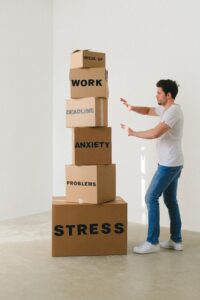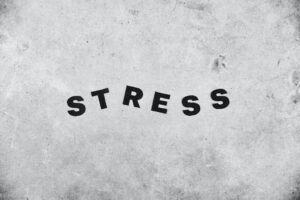Definition and Types of Anxiety
Anxiety is a common mental health condition that can significantly impact a person’s daily life. The Anxiety and Depression Association of America estimates that about 40 million adults in the United States are affected by anxiety disorders, making anxiety the most common symptom of mental illness.
While medication can be effective in treating anxiety, many individuals may prefer to explore alternative methods to reduce their symptoms. Fortunately, there are numerous non-pharmaceutical approaches available that can help manage anxiety without medication. In this article, we will explore these methods and provide practical tips on how to reduce anxiety naturally.
Definition and Types of Anxiety:
Anxiety is commonly characterized by excessive worry, fear, and feelings of apprehension. It is a normal response to stress or a potentially dangerous situation, but for some individuals, anxiety can become overwhelming and interfere with their ability to function. There are various types of anxiety disorders, including generalized anxiety disorder (GAD), panic disorder, social anxiety disorder, and obsessive-compulsive disorder (OCD).
Generalized anxiety disorder (GAD) is characterized by chronic and excessive worry about everyday life events and activities. Panic disorder involves recurrent panic attacks that can cause intense fear accompanied by physical symptoms like a rapid heart rate. Social anxiety disorder is characterized by a fear of being judged or embarrassed in social situations. Lastly, obsessive-compulsive disorder involves intrusive thoughts or obsessions that lead to repetitive behaviors or compulsions.
Understanding the different types of anxiety is crucial in determining the appropriate strategies to reduce symptoms. While medication is an option for managing anxiety, this article will focus on non-pharmaceutical techniques that can be equally effective in reducing anxiety levels and improving overall well-being. These techniques include deep breathing exercises, regular exercise, cognitive-behavioral therapy (CBT), progressive muscle relaxation, and natural remedies such as omega-3 fatty acids. By incorporating these methods into daily routines, individuals can take proactive steps toward reducing anxiety and improving their mental health.
Symptoms of Anxiety
Symptoms of anxiety can vary widely, both in their intensity and presentation. Some common physical symptoms of anxiety include a rapid heart rate, shortness of breath, sweating, trembling or shaking, muscle tension, headaches, and digestive issues. Psychological symptoms can manifest as excessive worry or fear, restlessness or feeling on edge, difficulty concentrating, irritability, sleep disturbances, and a sense of impending doom or panic attacks.
Individuals with panic disorder may experience sudden and intense fear, often accompanied by a pounding heart, chest pain, shortness of breath, dizziness, and a feeling of losing control. Those with generalized anxiety disorder may have persistent, excessive worry about various aspects of their lives, such as work, health, or relationships. This worry may be difficult to control and can interfere with daily functioning.
It is important to recognize these symptoms and seek appropriate help. Ignoring or neglecting anxiety symptoms can lead to worsening mental health and overall functioning. Seeking treatment for anxiety and learning effective coping strategies can significantly improve a person’s quality of life.
In conclusion, anxiety can manifest in a range of physical and psychological symptoms. Recognizing and addressing these symptoms is crucial for managing anxiety and improving overall well-being. Seeking help from a mental health professional is recommended for an accurate diagnosis and the development of an effective treatment plan.
Physical Symptoms
Physical symptoms of anxiety can manifest in various ways. Common physical symptoms include rapid heart rate, chest pain or tightness, shortness of breath, sweating, trembling or shaking, upset stomach or nausea, headaches, muscle tension or pain, and fatigue. These physical symptoms can be distressing and often contribute to the overall feeling of anxiety. It is important to recognize and address these physical symptoms, as they can significantly impact an individual’s daily life and well-being. In the following sections, we will explore effective ways to reduce anxiety without the use of medication to help alleviate these physical symptoms and promote overall mental health.
Heart Rate Increases
Heart rate increases are a common symptom of anxiety and can greatly impact our well-being. It is essential to address this issue as elevated heart rate can contribute to feelings of panic and discomfort.
When we experience anxiety, our body’s natural response is to initiate the fight-or-flight response, triggering the release of stress hormones such as cortisol and adrenaline. This leads to an accelerated heart rate, preparing us to deal with perceived threats.
However, prolonged or excessive heart rate increases can exacerbate anxiety symptoms. It can intensify feelings of panic, contribute to muscle tension, and even cause dizziness or lightheadedness. This vicious cycle can perpetuate anxiety and make it challenging to find relief.
Fortunately, there are effective techniques to manage heart rate and reduce anxiety symptoms. Deep breathing exercises can be particularly helpful. By taking slow, deep breaths and focusing on our breath, we activate the body’s relaxation response, reducing heart rate and promoting a sense of calm.
Regular physical exercise is another effective way to manage heart rate and alleviate anxiety. Engaging in activities like jogging, swimming, or cycling helps regulate heart rate, improve cardiovascular health, and release endorphins, the body’s natural mood enhancers.
In conclusion, addressing heart rate increases is crucial for managing anxiety symptoms. Deep breathing exercises and regular aerobic exercise can help regulate heart rate, reduce feelings of panic, and promote a sense of well-being. By incorporating these techniques into our daily routine, we can achieve a greater sense of calm and reduce anxiety without medication.
Breathing Becomes Shallow
When individuals experience anxiety, their breathing often becomes shallow. This shallow breathing contributes to the worsening of physical symptoms and can increase feelings of panic and discomfort.
Shallow breathing, also known as chest breathing, involves taking quick, shallow breaths that primarily engage the chest muscles. This type of breathing limits the amount of oxygen intake and hampers the body’s ability to effectively release carbon dioxide. As a result, individuals may experience dizziness, shortness of breath, and increased heart rate.
To counteract shallow breathing and promote relaxation, diaphragmatic breathing techniques can be highly beneficial. Diaphragmatic breathing, also referred to as belly or deep breathing, involves engaging the diaphragm muscle to expand the abdomen and facilitate a full inhalation and exhalation.
To practice diaphragmatic breathing, start by placing one hand on the abdomen, just below the ribcage. Take a slow, deep breath in through the nose, allowing the belly to rise as the diaphragm contracts and expands. Then, exhale slowly through slightly pursed lips, allowing the abdomen to fall as the diaphragm relaxes. Repeat this process several times, focusing on the sensation of the breath moving in and out of the body.
By practicing diaphragmatic breathing regularly, individuals can counteract shallow breathing and promote relaxation. This deep breathing technique helps to increase oxygen flow, decrease heart rate, and alleviate physical symptoms associated with anxiety.
Panic Attacks
An estimated 4.7% of U.S. adults experience panic disorder at some time in their lives. Panic attacks are sudden and intense episodes of extreme fear or discomfort. They can occur unexpectedly, even during sleep, and can severely impact daily life. During a panic attack, individuals may experience a racing heart, chest pain, shortness of breath, dizziness, and a sense of impending doom or losing control. These symptoms can be frightening and overwhelming, leading individuals to avoid certain situations or places for fear of experiencing another attack.
If you frequently experience panic attacks, it is important to seek help from a psychologist or other health professional who can provide an accurate diagnosis and recommend appropriate treatment options. While medication can be prescribed to manage panic attacks, there are also strategies you can try to reduce the frequency and severity of these episodes without medication.
One effective technique is deep breathing exercises. By practicing slow and controlled breathing, you can activate the body’s relaxation response and counteract the physiological symptoms of a panic attack. Again, diaphragmatic breathing might be a great way to counter symptoms. Take slow breaths in through your nose, allowing your belly to rise as your diaphragm expands, and exhale slowly through slightly pursed lips, allowing your belly to fall as your diaphragm relaxes.
In addition to deep breathing exercises, other relaxation techniques such as progressive muscle relaxation and mindfulness meditation may also help reduce the frequency and severity of panic attacks. It is important to find what works best for you and to be consistent in practicing these techniques. Remember, seeking professional help is vital in managing panic attacks, and your healthcare provider can guide you through the most appropriate treatment options based on your individual needs.
Stress Hormones Increase
When we experience anxiety, our bodies go into a physiological response commonly known as the “fight or flight” response. This response is designed to help us deal with a perceived threat or danger. One of the key aspects of this response is the release of stress hormones, such as cortisol and adrenaline.
When we encounter a stressor, whether it be a physical threat or a psychological stressor, our adrenal glands release cortisol and adrenaline. These hormones prepare our bodies for action by increasing our heart rate, boosting blood flow, and sharpening our senses. This response can be beneficial in short bursts, helping us to react quickly to situations that require immediate action.
However, prolonged exposure to stress hormones can have negative effects on our mental and physical health. When cortisol levels remain elevated for long periods, it can cause an increase in anxiety levels. Constant anxiety can lead to chronic stress, which can further disrupt the body’s natural regulatory systems and lead to a range of health problems.
It is important to find ways to reduce anxiety and lower stress hormone levels. Techniques such as deep breathing exercises, regular exercise, and practicing relaxation techniques can help to activate the body’s relaxation response, counteract stress hormones, and decrease anxiety levels. Additionally, seeking support from healthcare professionals or therapists can provide valuable guidance on managing anxiety and stress in a healthy way. By taking steps to reduce stress hormone levels, we can improve our overall well-being and reduce the impact of anxiety on our lives.
Causes of Anxiety
Anxiety is a common mental health condition that affects millions of people worldwide. While the exact causes of anxiety are not fully understood, it is believed to be a combination of genetic, environmental, and neurological factors. Some individuals may have a genetic predisposition to developing anxiety disorders, while others may develop anxiety as a result of experiencing traumatic events or chronic stress. Imbalances in brain chemicals, such as serotonin and dopamine, may also play a role in the development of anxiety.
Additionally, certain medical conditions and lifestyle factors, such as substance abuse and chronic illnesses, can contribute to the onset of anxiety. Understanding the potential causes of anxiety is important in order to better recognize and address this prevalent mental health condition.
Genetics
Genetics plays a significant role in the development of anxiety disorders. Various genetic factors contribute to the risk of experiencing anxiety symptoms. Research suggests that anxiety disorders have a heritability of around 30-40%, indicating that a portion of an individual’s susceptibility to anxiety is influenced by genetic factors.
The influence of specific genes on anxiety is still being studied, with several genes identified as potential contributors. For example, the ADRB2 gene has been associated with panic disorder, while the SLC6A4 gene has been linked to generalized anxiety disorder. Variations in these genes can affect the regulation of neurotransmitters like serotonin and norepinephrine, which are involved in anxiety regulation.
While specific genes may increase the risk of developing anxiety disorders, it is important to note that genetics alone do not determine whether a person will develop anxiety. Other environmental factors and individual experiences also play a role in anxiety development.
Understanding the genetic factors involved in anxiety disorders can help healthcare providers develop more personalized treatment plans for individuals experiencing anxiety. It also highlights the importance of early intervention for individuals who may be at increased genetic risk for anxiety, as targeted interventions and therapies can help manage symptoms and improve overall well-being.
Environment and Life Circumstances
Environment and life circumstances play a significant role in the development and exacerbation of anxiety disorders. Traumatic events, chronic stress, and a history of abuse can all contribute to heightened levels of anxiety.
Trauma, such as experiencing a natural disaster, being a victim of violence, or being involved in a serious accident, can have long-lasting effects on a person’s mental health. The intense fear and helplessness associated with such events can trigger the development of anxiety disorders. Similarly, chronic stress, which can result from ongoing financial difficulties, work pressures, or relationship problems, can gradually wear down a person’s resilience, leading to anxiety.
A history of abuse, whether physical, emotional, or sexual, can also have a profound impact on a person’s mental well-being. Having experienced such trauma can contribute to feelings of fear, mistrust, and hypervigilance, making individuals more susceptible to developing anxiety disorders.
On the other hand, social support and stable relationships can serve as protective factors against anxiety. Having a strong support system of friends, family, or a partner can provide a sense of belonging, validation, and emotional security, reducing anxiety levels. Additionally, having access to resources and socioeconomic stability can also alleviate anxiety, as financial burdens and basic needs are met, reducing stress and worry.
In conclusion, environment and life circumstances play a crucial role in the development and exacerbation of anxiety. Traumatic events, chronic stress, and a history of abuse can increase the risk of anxiety disorders, while social support and stable relationships can serve as protective factors. Recognizing these factors and seeking support when needed is essential for managing anxiety effectively and promoting overall well-being. Lastly, treating anxiety without medication is often a long-term goal. Reducing severe symptoms via medication offers initial improvements especially when used alongside cognitive behavioral therapy. It is important to discuss this alternative if needed and seek medication management from your physician or a psychiatric provider.






